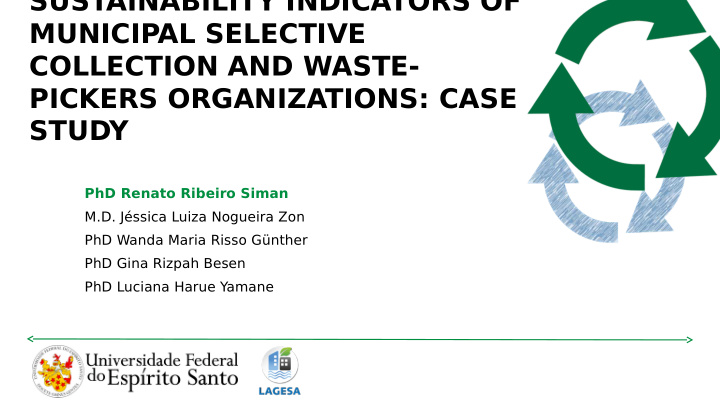



SUSTAINABILITY INDICATORS OF MUNICIPAL SELECTIVE COLLECTION AND WASTE- PICKERS ORGANIZATIONS: CASE STUDY PhD Renato Ribeiro Siman M.D. Jéssica Luiza Nogueira Zon PhD Wanda Maria Risso Günther PhD Gina Rizpah Besen PhD Luciana Harue Yamane
Introduction • There is a lack of consistent information on the performance of selective waste collection considering waste pickers organizations (WPO) participation • Sustainability indicators were chosen for being a current practice to evaluate the selective waste collection systems and a potential tool to support decision makers • This study determined the indices and the degree of sustainability of both, selective collection programs and the WPO, through 26 indicators and hierarchized emergency actions, categorizing which should be developed in the short, medium and long term giving high applicability to the study.
Background of selective collection sustainability indicators in Brazil • The Indicators of Sustainability of the Selective Collection (ISSC) and Indicators of Sustainability of the Picker Organizations (ISPO) used in this research were based on previous studies of by Lima (2006) • Besen (2011) started the process of constructing and validating indicators that could be used as a reference for the management, evaluation, and monitoring of municipal selective waste collection and WPO • The indicators originally validated in 2011 have been under updates, reaching their latest version in 2017 by Besen et al. (2017)
Material and Methods Study area
Material and Methods Data collection The collection of primary data from WPO was performed through the application of two questionnaires involving open and closed questions: Questionnaire I was applied in order to collect primary data to calculate sustainability indicators and index of the selective waste collection programs using the Google Forms online tool and was applied to managers responsible for the selective collection programs of each selected municipality Questionnaire II was applied through an individual interview, conducted face-to-face with the president of the organization by a multidisciplinary team.
Material and Methods ISSC ISSC Form of measurement Form of measurement Goal Goal Indicators of Existence of: service contract (VF), agreement Existence of: service contract (VF), agreement Legal instruments in the Legal instruments in the Measure the existence of legal Measure the existence of legal with fjnancial transfer (F), without fjnancial with fjnancial transfer (F), without fjnancial relation of the city with relation of the city with ISSC 1 ISSC 1 instruments in the relationship between instruments in the relationship between transfer (U), no contract or agreement (FU) transfer (U), no contract or agreement (FU) waste collection service waste collection service city halls and WPO city halls and WPO providers providers Sustainability of the Measure the coverage that selective Measure the coverage that selective waste collection service achieves in waste collection service achieves in ISSC 2 ISSC 2 Population attendance Population attendance terms of the number of inhabitants terms of the number of inhabitants Selective Collection served. served. Charge of rate or rate that: covers the cost of Charge of rate or rate that: covers the cost of the service including selective collection (VF), the service including selective collection (VF), Measure the economic sustainability of Measure the economic sustainability of ISSC 3 ISSC 3 Self-fjnancing Self-fjnancing covers the entire cost of the service (F), do not covers the entire cost of the service (F), do not waste management organization. waste management organization. (ISSC) cover service costs (U), Budget only (VU) cover service costs (U), Budget only (VU) Measure the education and Measure the education and Education and Education and ISSC 4 ISSC 4 dissemination of actions carried out in dissemination of actions carried out in dissemination dissemination favor of selective waste collection. favor of selective waste collection. Evaluate the diversity of partnerships Evaluate the diversity of partnerships ISSC 5 ISSC 5 Partnerships Partnerships articulated by municipalities in the articulated by municipalities in the selective waste collection selective waste collection Measure the efgectiveness of selective Measure the efgectiveness of selective collection, and the effjciency of the collection, and the effjciency of the ISSC 6 ISSC 6 Population adherence Population adherence education/communication process, education/communication process, environmental, social and economic environmental, social and economic outcomes. outcomes. Measure the effjciency of the selective Measure the effjciency of the selective waste collection system and the waste collection system and the ISSC 7 ISSC 7 Recycling rate Recycling rate diversion of the dry waste from the diversion of the dry waste from the landfjll. landfjll. Working conditions in the Working conditions in the Evaluate working conditions during dry Evaluate working conditions during dry ISSC 8 ISSC 8 collection of dry waste collection of dry waste waste collection. waste collection. Measure the cost of selective waste Measure the cost of selective waste Costs of the selective Costs of the selective ISSC 9 ISSC 9 collection in relation to the amount of collection in relation to the amount of waste collection service waste collection service waste collected in the municipality. waste collected in the municipality. Measure the percentage between the Measure the percentage between the Cost of selective waste Cost of selective waste cost of the selective collection and the cost of the selective collection and the ISSC 10 ISSC 10 collection / regular + collection / regular + cost of the regular collection plus to the cost of the regular collection plus to the fjnal disposal fjnal disposal fjnal disposal. fjnal disposal.
Recommend
More recommend